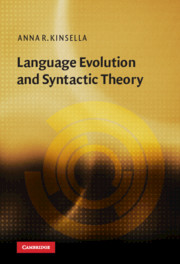Book contents
- Frontmatter
- Contents
- List of figures
- List of tables
- Preface
- List of abbreviations
- 1 Constraining our theory of language
- 2 Language as a perfect system
- 3 Language as an evolvable system
- 4 Language as a recursive system
- 5 Language as a minimal system
- 6 Towards an evolvable theory of syntax
- Bibliography
- Index
3 - Language as an evolvable system
Published online by Cambridge University Press: 30 September 2009
- Frontmatter
- Contents
- List of figures
- List of tables
- Preface
- List of abbreviations
- 1 Constraining our theory of language
- 2 Language as a perfect system
- 3 Language as an evolvable system
- 4 Language as a recursive system
- 5 Language as a minimal system
- 6 Towards an evolvable theory of syntax
- Bibliography
- Index
Summary
Introduction
This chapter will be concerned with the second issue formulated at the end of chapter 1: the issue of simplicity, in isolation from perfection. A brief review of the ways in which the minimalist language faculty can be interpreted as simple will be followed by an examination of the opposite standpoint – that the language faculty is, in fact, highly complex, intricately organised, and operates in an elaborate, and sometimes tangled, manner. This will motivate a discussion of the issues surrounding measuring complexity, and what it might mean for the language faculty to be complex, or indeed simple. These issues will then be directly linked to the evolutionary possibilities of the language faculty, firstly by questioning the accuracy of assumptions that evolution proceeds in the direction of greater complexity. Following this, the methodological choices made by the minimalist, which were hinted at in chapter 2, will be subjected to scrutiny, and it will be shown that the assumptions made lead to a system of language whose evolutionary possibilities are both highly constrained and biologically unlikely. In the final section of this chapter, the question of what an evolvable system of language would look like will be informed by detailed examination of a number of characteristics closely associated with the property of evolvability.
The simplicity of the minimalist language faculty
The minimalist language faculty differs from the system envisaged in other frameworks primarily through reduction of the apparatus it entails to only that which is conceptually necessary. Levels of representation are fewer, as are permissible operations, and objects subject to these operations (more specific details are offered below).
- Type
- Chapter
- Information
- Language Evolution and Syntactic Theory , pp. 70 - 111Publisher: Cambridge University PressPrint publication year: 2009

